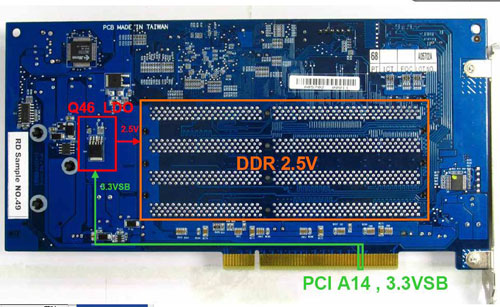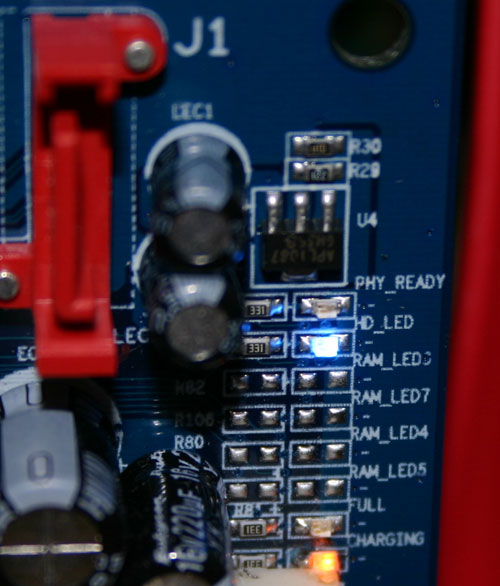Gigabyte's i-RAM: Affordable Solid State Storage
by Anand Lal Shimpi on July 25, 2005 3:50 PM EST- Posted in
- Storage
i-RAM's Limitations
Since your data is stored on a volatile medium with the i-RAM, a loss of power could mean that everything stored on the card would be erased with no hopes for recovery. While a lot of users may keep their computers on 24/7, there are always occasional power outages that would spell certain doom for i-RAM owners. In order to combat this possibility, Gigabyte outfitted the i-RAM with its own rechargeable battery pack.
There are only three conditions where the i-RAM runs off of battery power:
1) When the i-RAM is unplugged from the PCI slot;For whatever reason, unplugging the i-RAM from the PCI slot causes its power consumption to go up considerably, and will actually drain its battery a lot quicker than the specified 16 hours. We originally did this to test how long the i-RAM would last on battery power, but then were later told by Gigabyte not to do this because it puts the i-RAM in a state of accelerated battery consumption.
2) When the power cable is unplugged from your power supply (or the power supply is disconnected from your motherboard; and
3) When the power button on your power supply is turned off.
For the most part, the i-RAM will always be powered. Your data is only at risk if you have a long-term power outage or you physically remove the i-RAM card.
If you run out of battery power, you will lose all data and the i-RAM will stop appearing as a drive letter in Windows as soon as you power it back up. You'll have to re-create the partition data and copy/install all of your files and programs over again.
The card features four LEDs that indicate its status: PHY_READY, HD_LED, Full and Charging.











133 Comments
View All Comments
crazySOB297 - Monday, July 25, 2005 - link
I'm surprised they didn't raid a few of them... I think you could get some huge performance.Googer - Tuesday, July 26, 2005 - link
Not to mention it is a way to also get around the 4gb siza limitation.
Hacp - Monday, July 25, 2005 - link
Dude the article said straight out that SATA150 was the only format supported. Read the entire article.Guspaz - Monday, July 25, 2005 - link
I too am dissapointed that the article lacked any mention of SATA2, which is twice as fast as SATA (300MB/s vs 150MB/s). Considering many motherboards already on the market suport SATA2, and the 300MB/s transfer rate that goes with it, it is a bit of an oversight that the articles doesn't even MENTION if the card supports SATA2 or not. Nor do they mention what they think would happen with SATA2, or if Gigabyte is likely to produce a SATA2 version. It's a weak spot in this article, I think, considering how central the bandwidth of SATA is to the performance of the i-RAM.snorbert - Tuesday, July 26, 2005 - link
33MHz PCI only gets you 133 MB/sec theoretical, and more like 110 MB/sec in the real world. The i-RAM with SATA 1 can completely saturate a PCI bus. SATA2 would cost more to implement, and give you no speed increase at all on a 33MHz bus. If you build the card for higher-end PCI specs (e.g. 66MHz, 64 bit, 66MHz/64bit, PCI-X) then you automatically exclude most PC enthusiasts (unless they like buying server boards for their game boxes).
If they end up doing a PCI Express version, then there would be some reason to support SATA2.
This board is not a replacement for a hard drive. It would be incredibly useful as a transaction log though. Reliable (i.e. won't get lost if the machine crashes) write-behind caching for RAID 5 drives will give you a huge boost to write speeds. And the controller cards that support battery-backed write behind caching cost a lot more money than an i-RAM.
-Jason
sprockkets - Tuesday, July 26, 2005 - link
Also to reply hereKeep in mind that for many years the ide/sata controllers are NOT on the PCI bus of the southbridge, so PCI is not a limitation.
snorbert - Tuesday, July 26, 2005 - link
Actually, scratch my comment - I had not had enough coffee when I wrote it. I forgot that the PCI connector is doing essentially squat except providing power to this device. Of course you could have a SATA2 controller on a faster bus talking to this thing. But an SATA2 version would probably cost more. (because it would need a faster FPGA, newer SATA transceivers)Sorry folks,
Jason the doofus
Anton74 - Monday, July 25, 2005 - link
You did miss that reference; on page 2 it says "The i-RAM currently implements the SATA150 spec, giving it a maximum transfer rate of 150MB/s".Given the 1.6GB/s of the RAM, it seems completely silly not to provide a 300MB/s SATA interface instead, especially considering that the whole contraption including RAM will cost as much as 2 or more decent hard drives.
Anton
ryanv12 - Monday, July 25, 2005 - link
The controller on the card is not SATA-II...it can do a max of 1.6GB/s...not exactly SATA-II speeds there...Anton74 - Monday, July 25, 2005 - link
1.6GB/s is actually more than 5 times 300MB/s, the maximum supported by SATA-II. So 300MB/s could easily be fully utilized, and I don't understand why they didn't support that.Anton